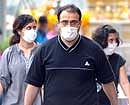WHO warns of severe form of H1N1

Some countries are reporting that as many as 15 per cent of patients hospitalised with the new H1N1 pandemic virus need intensive care, further straining the already overburdened healthcare systems, WHO said in an update on the pandemic.
“During the winter season in the southern hemisphere, several countries have viewed the need for intensive care as the greatest burden on health services,” it said.
“Preparedness measures need to anticipate this increased demand on intensive care units, which could be overwhelmed by a sudden surge in the number of severe cases.” Earlier, WHO reported that H1N1 had reached epidemic levels in Japan, signalling an early start to what may be a long influenza season this year, and that it was also worsening in tropical regions. “Perhaps most significantly, clinicians from around the world are reporting a very severe form of disease, also in young and otherwise healthy people, which is rarely seen during seasonal influenza infections,” WHO said.
“In these patients, the virus directly infects the lung, causing severe respiratory failure. Saving these lives depends on highly specialised and demanding care in intensive care units, usually with long and costly stays.
Minority groups and indigenous populations may also have a higher risk of being severely ill with H1N1.“In some studies, the risk in these groups is four to five times higher than in the general population,” WHO said.
“Although the reasons are not fully understood, possible explanations include lower standards of living and poor overall health status, including a high prevalence of conditions such as asthma, diabetes and hypertension.”
WHO said it was advising countries in the Northern Hemisphere to prepare for a second wave of pandemic spread. “Countries with tropical climates, where the pandemic virus arrived later than elsewhere, also need to prepare for an increasing number of cases,” it said.Every year, seasonal flu infects between 5 per cent and 20 per cent of a given population and kills between 250,000 and 500,000 people globally. Because hardly anyone has immunity to the new H1N1 virus, experts believe it will infect far more people than usual, as much as a third of the population. The good news — people infected with AIDS virus do not seem to be at special risk from H1N1, WHO said.
‘Flu spreading at an unbelievable rate’
Paris, afp: Swine flu spreads four times faster than other viruses and 40 per cent of the fatalities are young adults in good health, World Health Organisation Director General Margaret Chan told Le Monde daily in an interview. “This virus travels at an unbelievable, almost unheard of speed,” Chan said. “In six weeks it travels the same distance that other viruses take six months to cover,” Chan said. More than 2,180 people around the world have died from the virus since it was uncovered in April.
Chan also said that it could be months before sufficient vaccine is available to combat the pandemic. She put world production capacity at 900 million doses a year, for a global population of 6.8 billion people.
Deccan Herald is on WhatsApp Channels| Join now for Breaking News & Editor's Picks